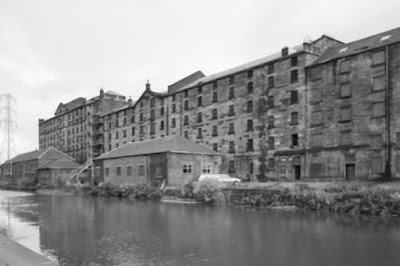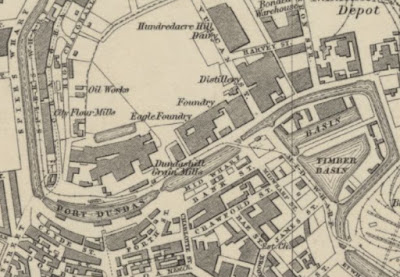Stunning Engineering Old And New
At Grangemouth, the original route oif the Forth and Clyde canal ran from bottom left on the above Google Earth extract to the top right, where we see the start of the Forth-Clyde Way, the road built on the canal's route. The watercourse now tuns sharp left and leads to ...... the Kelpies.
The sculptures were opened to the public in April 2014. As part of the project, they have their own visitors‘ centre, and sit beside a newly developed canal turning pool and extension. This canal extension reconnects the Forth and Clyde Canal with the River Carron, and improves navigation between the East and West of Scotland.
Just beyond the Kelpies is he lock that leads into the River Carron and on into the Forth.Here is the new link c/o Google Earth ...... and on Open Street Map.The channel that leads off right from the Kelpies and under the M9 ...
... also connects with the river.Sailing geographically from east (Forth) to west (Clyde) this is the first piece of big engineering to be part of the rebuild and re-opening of the defunct canal.
Next up (as they say) is the most memorable site.But, pedantically, The Falkirk Wheel is not part of the Forth and Clyde canal.
One of the benefits of John Smeaton's design was that boats could link to the Union Canal near Falkirk and sail all the way to quays in Edinburgh. Connection was by a long lock ladder.When passenger boats ran (slowly!) between the two great Scottish cities, some customers found it quicker to alight from the vessel at the foot of the ladder, travel up the hill by carriage and join their onward boat at the top (anf vice versa).
The Union Canal opened in 1842, but diminished its value as a transport medium. It fell into slow commercial decline and was closed to commercial traffic in 1933. It was officially closed in 1965. The canal is listed as a scheduled monument by Historic Scotland.
It has benefited from a general revival of interest in canals and, as a result of the Millennium Link, was reopened in 2001 and reconnected to the Forth and Clyde Canal in 2002 by the Falkirk Wheel. It is now in popular use for leisure purposes.
A piece of original canal engineering can be found at Kirkintilloch, about half way between the Forth and the Clyde.It is an aqueduct which originally crossed a railway.The canal crossed both the Luggie Water (a stream) and the railway branch to Lennoxtown (The Campsie Branch). The railway is now the obligatory footpath and cycleway but the stream remains.There was considerable interest in 1900 watching the trains negotiate the Luggie in flood.Proceeding west the next big renewal project is at Stockingfield Junction.We've got an aqueduct, the junction, a bridge and a park; all courtesy of canal regeneration. But, notably, we've got one of hese.The influential and successful businessmen of Glasgow were less than pleased when Mr Smeaton looked as if he were by-passing the city centre. But worry not; a branch was dug which served wharves in the centre and connected with the Monkland Canal.Most of the Monkland is abandoned and filled in but one intriguing remnant remains in the centre of Glasgow. This pedestrian subway was once part of the canal ...... where the gouging of the tow ropes is still extant on the corner post!
Because of the work on the M8 which filled in some sections, the "terminus" at Port Dundas has been substantially rebuilt ...
...with warehouses now gentrified as residential premises.
Below is a plan of the Port Dundas area in approx 1900 ...... showing the connection to the Monkland Canal bottom right. And today's plan ...... has just a dribble of the former Monkland connection bottom right. fbb thinks even that dribble is now dry!
But, back to the Junction. The pieces of string attached to the intriguing tower are supporting swirly footbridges across the junction. This how it was ...... and this is how it is! (viewed from roughly the same direction).Stunning.
And we mustn't forget the Stockingfield "aqueduct".When is an aqueduct a tunnel? Hmmm? Maybe it is an aqueduct because it is all one big chunk of construction. A tunnel would be under he earth and under the canal - perhaps.
This blog will conclude tomorrow.
Next Canal Engineering blog : Saturday 29th July

























There is another subway that was once a canal, in central Cardiff by the castle: https://www.walesonline.co.uk/news/wales-news/cardiff-history-canal-castle-facts-20674020
ReplyDelete